Not so. No, if I let it, this post would be at least twice as long as Monday's. Fortunately, it's not going to be that. It's a basic primer for those with a fledgling interest in wrestling games who don't know the world beyond Smackdown vs. Raw and No Mercy. It's also a general purpose article for those with an interest in videogame history. There will be copious links provided at the end for those who wish to know more. That being said, let's get started with what you might already know.
Fictional Wrestlers
A very good place to start, as they were the first pro wrestling videogames. In fact, a couple of the early ones were just called Pro Wrestling. The best known of these is the NES game, developed by Nintendo R&D3 (the folks behind Punch-Out!! and StarTropics, to name a few). It gives each grappler a punch, a kick, a few standard grapples (body slam, belly-to-back suplex) and some unique moves. Interestingly, every wrestler can toss his opponent from the ring and execute a tope on their prone foe. This is, I'm fairly certain, the first videogame tope, and it wasn't something seen again for awhile.
The cast sets a good precedent that fictional grapplers would follow for, well, ever, really, in creating a cast that are fairly thinly veiled analogues of real pro wrestlers. Fighter Hayabusa is New Japan Pro Wrestling boss and star Antonio Inoki, Starman is the first major lucha libre (Mexican wrestling) star Mil Mascaras, Giant Panther is Hulk Hogan, Kin Corn Karn is Japanese/Korean star Rikidozan, The Amazon is equal parts Abdullah the Butcher and Bruiser Brody, King Slender is "The Nature Boy" Ric Flair and the final, unplayable boss Great Puma is Japan's iconic Tiger Mask. The game is still surpisingly solid today, but also was one of the early wrestling titles to use the "grapple, then mash buttons to see who gets to do their move" system that plagued so many wrestling games through the 16-bit era. A turbo controller is highly recommended for enjoyment now.


Tell me you don't see the resemblance.
There was also a Master System game of the same name, that seems to hew very closely to Namco's Tag Team Wrestling, which, aside from providing the source material for Homestarrunner.com's Strong Bad, is entirely forgettable. Other early games include Title Match Pro Wrestling for the Atari 2600 and 7800, as well as the Intellivision game Body Slam: Super Pro Wrestling. I've honestly never played the Atari game, and the Intellivision one is... not good.
Later, on the NES, we would see Tecmo World Wrestling, which isn't horrible, but half of the screen is taken up by a guy providing color commentary in text boxes. The highlight of that particular game are the close up, semi-cut scene style showings of big moves. The gameplay stops, zooms in, and you see your wrestler drop his finisher on your opponent, up close. Or you see yourself get pummeled up close, either way. This game also features caricatures of real wrestlers.
One NES game I have a soft spot for for no real discernable reason is M.U.S.C.L.E. Honestly, I understand the game is just completely awful, but I like it anyways. I think it's because I was obsessed with the little figures when I was a kid. M.U.S.C.L.E., if you were unawares, was actually based on a Shonen Jump manga called Kinnikuman, which follows the adventures of a bunch of super crazy powered space wrestlers... or something. Hell, I don't know. I just know the figures were sweet when I was little and the games got much better in the PS2/Gamecube era when AKI (makers of WWF No Mercy) took over development. Those games were based on the cartoon from the early 2000s which followed the exploits of Kinnikuman's son. It was localized here as "Ultimate Muscle," and aired on Fox Kids. The games used a system very similar to No Mercy, but with more superpowered slams and various rings. The best of the series released here is Galactic Wrestling featuring Ultimate Muscle.

The 16-bit era eased up on the fiction a bit, but we still saw Hammerlock Pro Wrestling and Natsume Championship Wrestling, both on SNES. These were both actual Japanese puroresu games that were localized to feature fictional wrestlers. The former was based on Genichiro Tenryu's Pro Wrestling Revolution: Wrestle & Romance, the latter on All-Japan Pro Wrestling. They're both middling at best, and if we were going to get ports of Japanese wrestling games, there are other SNES ones I'd've much rather had, but we'll get more into that later.
Capcom also was nice enough to bring us a few fictional grapplers, but only one got a console port. I'm sure many fondly remember Saturday Night Slammasters, both for Genesis and the SNES. It was ported from the arcade, and, even though it falls back a little on button mash-y grapples, it also included crazy special moves, and a glimpse at future Metro City mayor Mike Haggar's wrestling career, as he is one of the selectable characters. Capcom is also less bad about blatantly copying real wrestlers. While it's obvious that King Rasta is Bruiser Brody and Great Oni is Great Muta, the rest are pretty hard to pin down. Jumbo Flapjack could be John "Earthquake" Tenta, but he could also be Abdullah the Butcher. In a neat crossover, Biff Slamkovich references Zangief in his winning quote.
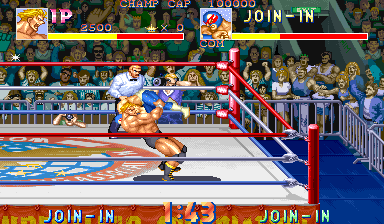
The console versions are pretty similar, but the Genesis version includes a death match option that surrounds the ring in barbed wire or electric ropes. The SNES version looks closest to the arcade and had four player support with the multitap. There was an arcade only pseudo-sequel called Muscle Bomber Duo that improved on the first game, but removed the option for 1-on-1 matches, it's basically Saturday Night Slammasters: Championship Edition. There was then a full-fledged sequel, but it had limited US release (I've never played it), and apparently is a traditional 2D fighter with wrestling ring backgrounds.
Of course, in the '90s, anything Capcom could do, SNK was bound and determined to attempt to do better, so they dropped 3 Count Bout on the Neo-Geo. A fully fictionalized roster with many transparent stand-ins (Terry Rogers is obviously Hulk Hogan with hair, even more obviously when you know Hulk's real name is Terry), but a really oddly great single player that involves death matches and even a parking lot brawl that allows you to grab a backstage interviewer and throw him at your opponent. Unfortunately, the oppressive difficulty, which stems from horrid button mashing that begins to always go in the CPU's favor after about two matches, makes the game pretty unfun, unless you're playing the AVS version and can scale the difficulty down.

The last grappler I remember being released with a fully fictional roster is Power Move Pro Wrestling from Activision for the PS1. It was also the first 3D wrestling game that came to the US. Power Move is actually a rejiggered version of the first New Japan game (Toukon Retsuden) for PS1, basically getting the same treatment as Natsume Championship Wrestling. It's basically WWF Smackdown 0, as it was developed by Yuke's and uses a really primative version of the same engine. It's only interesting as a curio now, as each guy only has about four grapples, there's no single player to speak of, and there's literally no match options besides 1-on-1. The instruction book is kind of neat, though, as they went to the trouble to flesh out all of the fictional grapplers' stories and rivalries.
WCW
I'm gonna be 100% honest with you here, dear reader. WCW's videogame output was about as good as their product, which is to say, it had some high points between 1997 and 1999, but other than that, it was garbage. The first WCW games were developed by Pony Canyon/FCI, and the first one, WCW Wrestling for NES, wasn't even a WCW game when it was developed. It was actually a game called Super Star Pro Wrestling that featured a variety of actual puroresu stars from various Japanese promotions.
The localization is so horrifically bad that even though the Road Warriors (a.k.a. Legion of Doom) are in both games, the version of Hawk in WCW Wrestling is actually Stan Hansen in Super Star Pro Wrestling, while the SSPW version of Hawk somehow became Michael "P.S." Hayes in the American game. The game is overly hard, uses that same button mash-y style and the wrestler's signature moves rarely line up with what their actual finishers were.
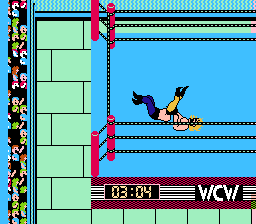
The second Pony Canyon WCW game was years later for the SNES and was called WCW Superbrawl Wrestling. It was actually developed by Beam Software, who gave us Back to the Future II & III for NES. You can imagine what it might be like. The game, quite frankly, is inscrutable. The HUD is crowded and sloppy and the controls are awful. It makes Acclaim's WWF efforts look like Super Mario Bros. 3. It's embarrassing. It should be avoided.

Superbrawl Wrestling's horrific character select screen. Yes, that is Johnny B. Badd you see there.
There were Gameboy games from Pony Canyon, too, but I've never played them. Based on what I know about the console WCW games and wrestling games on the black & white Gameboy, I think I'm better off.
They got better after that for two games, while AKI was handling their N64 output, and I would say that WCW/nWo Revenge is the best wrestling game to not feature a character creation tool. The only problem with these games now is that they are surpassed in every way by the WWF games that AKI made for the N64. I'm also told that AKI's Japan-only follow up, Virtual Pro Wrestling 2 shames these early efforts.
THQ also had some PS1 games (later ported to N64 and PC) developed, but not by AKI or by Yuke's, who would handle their WWE games once they took over that license. The games in question are WCW vs. the World, WCW Nitro and WCW Thunder. I bought Nitro the day it came out, and the friendly guy at Funcoland tried hard to dissuade me. I would not be dissuaded. I can only wish now that I had listened to him.

Developed by Inland Productions, the games both feature horrid graphics, no single player to speak of, an obnoxiously limited move set, and should just generally be avoided. The only redeeming factor are promos you can watch on the character select screen. Seriously, that is the only interesting thing about these games.
WCW vs. the World actually came before those, and was developed by AKI. It plays similarly to their N64 titles, but has fewer moves for each wrestler. Largely forgettable today.
After THQ lost the WCW license, EA won the bid. This is not the EA we know today that released things like Rock Band, Mirror's Edge and Left 4 Dead. No, this was the old, bad EA. This is an EA that released a myriad of awful WCW games, including one that was a wrestling game without a ring. I'll say that again; they released a wrestling game that HAD NO RING.
.gif)
Who needs a ring when you can have a Jeff Jarrett mirror match?
I talked Monday about how bad Wrestlemania XIX for Gamecube was, but at least under all the stupid crap there was a point at which you wrestled. In a wrestling ring. EA, though, they released WCW Backstage Assault. What's the demographic for that, exactly? People surveyed revealed that their favorite part of wrestling programs were the muggings guys gave each other in the backstage areas? Are you joking?
Sadly, faithful readers, they were not. The predecessor, WCW Mayhem had a ring, and was pretty much just as awful. The system was just sloppy. It was a quick cash-in from the old EA. Apparently, they were starting to get it, and handed development of WCW Mayhem 2 to AKI, but, as we know, WWF bought WCW in 2001 and that game never reached shelves. EA would take AKI's beginnings of that game and create Def Jam Vendetta, more on that later.
ECW
ECW was only a strong enough promotion to have two videogames made. Both were done by Acclaim and they were continuations of the WWF Warzone series. It was nice at the time to see Rob Van Dam, Justin Credible and the ECW crew in game format, but the games themselves were derivative, offering little over what WWF Attitude had already offered.

The first game was for PS1, Dreamcast, N64 and Gameboy Color. I've never played the GBC games, but the other versions are entirely skippable in favor of Anarchy Rulz for PS1 and Dreamcast, which, honestly, is also not really worth a lot of your time unless you have some serious ECW nostalgia. Smackdown vs. Raw included ECW in their rosters for the last three years, but there was nothing inherently ECW-esque about the brand in any of those games.
Puroresu
Puroresu games often come to the US with fake casts, as we've discussed. Others just stay in Japan. Most of them we've kind of touched on by this point, but there are two that I want to touch on in particular. The first is a series that was actually done by a first party. Sega produced three All Japan Pro Wrestling games, one for Saturn/arcade, two for Dreamcast. None of them made it out of Japan, which is a shame because they're very, very good.
The first is called All Japan Pro Wrestling featuring Virtua, because it (like the others) featured a couple of characters from Virtua Fighter. It set the tone, but all the games basically build off of the same system and only get better. Giant Gram 2000 for Dreamcast is generally considered the best of the bunch. What makes the games great is the system. It's very basic, using a rock-paper-scissors system which means throws beat grapples, grapples beat attacks, and attacks beat throws.

The thing that makes the game really unique, though, is the combo system. For example, if you are using a character that has a verical suplex, doing a button imput (often down and B) at just the right time turns it into a brainbuster. The reversal system works on a similar principle. Unlike Smackdown vs. Raw, or even No Mercy, wherein you just press the counter button before the grapple, Giant Gram requires the timing on a reversal be perfect to the time of an opportunity for reversal during the manuver. The Dreamcast titles also feature robust create a wrestler modes.

The other puroresu game I wanted to mention is King of Colosseum. It's developed by Spike, who is mostly Human expatriates. It is fully licensed by all the major Japanese wrestling promotions, and uses an extremely deep grappling system. It would be difficult to describe here, and it takes some time to learn, but it's worth it. My favorite thing about the series, though, is it's emphasis on wrestling psychology, something very few games even touch on. In KoC, in order to advance, in order to have a successful match, you must please the crowd. This means letting your opponent get an advantage on you, in order to make a big comeback. I highly recommend the last game in the series, King of Colosseum II, as the first few games break up the federations between them.
Fire Pro Wrestling
A series so well known, so grand, so critically lauded that it deserves its own heading. Fire Pro Wrestling began life on the PC Engine in 1989 with Fire Pro Wrestling Combination Tag, developed and published by Human Entertainment only in Japan. The game was a vast departure from earlier wrestling games in that button mashing was the fastest path to a loss. Fire Pro Wrestling Combination Tag required the player to time their grapples.
When two wrestlers approached each other, they would automatically lock up, after a moment, they would bend their knees. Hitting an attack button exactly at the moment you bent your knees would result in you executing your move, unless you attempted a move that was too powerful too early, and you opponent attempted a weaker, faster move. Over time, the only change to this system is that in more recent games, the wrestlers now rear back before lunging forward and locking up, and now the correct timing is exactly when you make contact for the lockup. Other than that, the basic system is the same.
Naturally, with more games came more moves, taunts, entrances, more wrestlers in the ring and, perhaps most importantly, a more robust single player experience. Several of the games feature very fully developed stories, not only for their time, but for wrestling games in general. In fact, if you've ever wondered why Suda51 puts wrestling moves and references in so many of his games, it's because he got his start as a scenario writer for Human working on the Fire Pro series. In fact, he set the tone for his work pretty early when he wrote the scenario for Super Fire Pro Wrestling Premium for the Super Famicom (Japanese Super NES). In that game, your character falls in love with Akira Maeda's (fictional) sister, but the love goes unrequited and after winning the World Heavyweight Championship, he kills himself.
.gif)
Speaking of the player characters, each Fire Pro entry has a pretty large cast, with the most recent having over three hundred characters, with slots to create over one hundred more. The characters themselves aren't really fictionalized versions of real wrestlers. No, they're more like real, actual wrestlers with different names. They look, taunt, fight and use the finishers of their real life counterparts, and there are entire FAQs online dedicated to helping you go through the (extremely tedious) task of renaming all the characters to their real names.
The series has well over twenty entries, so discussing them all here is nearly impossible, but rest assured, this is not a series in which the most recent entry is the only one worth playing. In fact, while Fire Pro Wrestling Returns for the PS2 is by far the best game from a mechanics standpoint, it is woefully light on single player modes. That being said, it's the only console game in the series to get a US release, and at release it was only twenty bucks, so there's not a compelling reason to not own it, if you're into wrestling and videogames. Still, though, the major draw in terms of single player is a mode in which you become a promoter and book shows and can play out all of your matches. The only problem with it is you can't use your edits (created characters in Fire Pro lingo) in this mode, and making edits is one of the biggest draws to the game, so the mode becomes much less compelling.

The casts also vary from game to game, including one game for the PC Engine Duo that is entirely a Joshi (Japanese women's wrestling) game. Fire Pro Wrestling D for Dreamcast is also very highly regarded, as well as Super Fire Pro Wrestling X Premium. The first taste we got of the series wasn't until the 2001 launch of the Gameboy Advance, and the two games that got US release (Fire Pro Wrestling and Fire Pro Wrestling 2) are also very good, and portable, which is a bonus! The only shame there is that Fire Pro Wrestling 2's biggest draw was it's Management of the Ring mode, which put you even more in the shoes of a promoter than Fire Pro Wrestling Returns single player, as it required you to buy TV time, develop merch, etc. was cut due to the amount of work the (small) US publisher would've had to sink into localization.

Spike, the current owner of the Fire Pro series (made up mostly of Human expats, following that company's dissolution) have said that Fire Pro Wrestling Returns is the last in the series, but I have my doubts (and hopes!) that that isn't true.
Miscellany
I know I didn't cover every single non-WWE wrestling game here, but this post is already crazy long, and I didn't think it needed to be any longer. Still, there are a few games that don't fit into any of the above categories that I think need to be addressed. Just a quick rundown of some other games out there.
The first is TNA Impact. I had high hopes for this game. I read many developer interviews in which I was told the team was basically trying to recapture what made WWF No Mercy great while adding a modern design sensability. This did not happen. In fact, I'm not sure if the team had even played No Mercy, because this game was nothing like it, and while it was, I guess, playable at best, it was repetative with a wonky grapple system. Still, it was better than having to watch TNA, so that's something. It was done by Midway, who has since dissolved (and there are rumors that this game's high investment and low sales were a factor in that), so I'm not sure who has the TNA license now or if we'll even see another game.
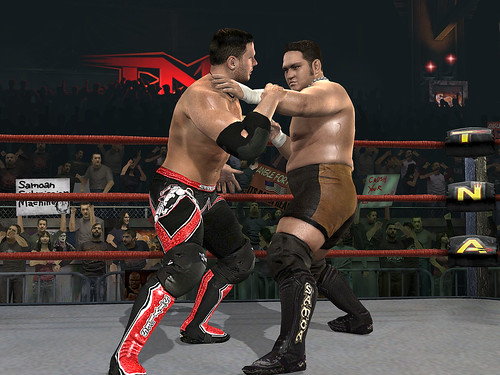
Looks good. Plays horribly.
To move on to a pair of games that actually did resemble No Mercy, let's talk about the first two Def Jam games for a second. Def Jam Vendetta was a wrestling game featuring rappers, developed my No Mercy developer AKI. I'm not sure that there's much more that needs to be said here. It's a follow up to No Mercy in which I can play as Method Man. Sold. On the filp side, there's no create modes, so you're stuck with the default roster. By all accounts, this is what became of WCW Mayhem 2 after EA was stuck without a WCW license.
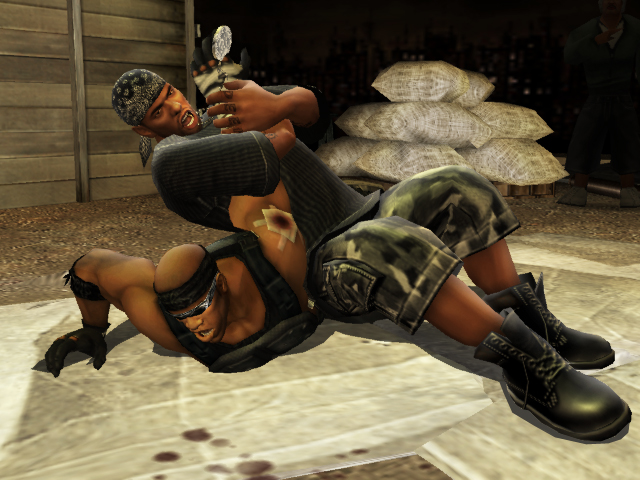
The game was successful, so EA put AKI right back to work and they came up with Def Jam: Fight for NY. At this point, you might be calling foul on me for talking bad about Backstage Assault, as by all appearances, this is a wrestling game without a wrestling ring. Not really. It's a game that came from wrestling games, but actually uses only KOs and submissions to end fights. It's really more of a fighting game informed by wrestling games.
AKI fixed most everything that was wrong with Def Jam Vendetta (which is to say, they added a create mode) and added former Black Flag frontman and spoken word genius Henry Rollins as a playable character. Again, sold. A game that allows for grudge matches between Henry Rollins and Dr. Foreman from "House, M.D." is automatically awesome. The game could've stood to have a ring, but still, it's very solid and it's from AKI. You can't go wrong. The third Def Jam game was handed to EA Chicago, was terrible, bombed and led to the shutdown of that studio. Let's not talk about it.
Speaking of things we shouldn't talk about, Eidos released two Backyard Wrestling games. They are literally games in which you wrestle in backyards. They feature members of the Insane Clown Posse as playable characters. You should stay far, far away from these games. They are an insult to both wrestling and backyards. In fact, in that way they are surprisingly faithful to their source material.
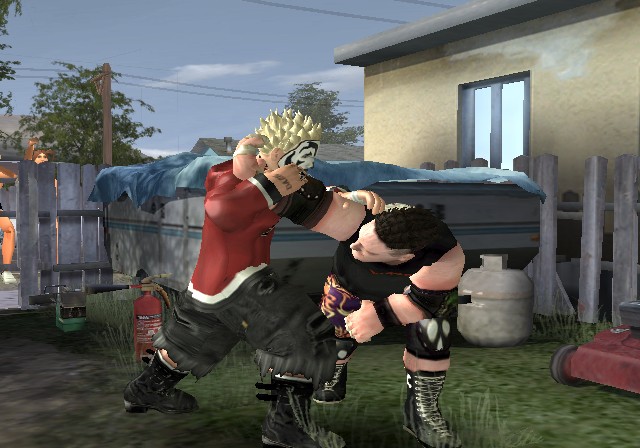
A real juggalo wouldn't fuck around with a wristlock, and a real backyarder can't do one.
There is only one lucha libre game I'm aware of, and it's not even out yet. Initially announced as AAA: El Videojuego, it's now known as Lucha Libre AAA 2010: El Heroes del Ring (Pro Wrestling AAA 2010: Heroes of the Ring). It's being developed by Immersion Software & Graphics and published by Slang. I am not familiar with either of those companies. I can only hope it isn't vaporware, because, as you can see by the body of this article, lucha libre in videogames is woefully under-represented.
So that's it. That's your primer for wrestling games. I know I left some out (Konami's Rumble Roses series, Yuke's Japan-only Wrestle Kingdom series, that crappy All-Star series Square-Enix did in Japan), but I think this post is enough to keep almost anyone busy for at least a little while. Check back tomorrow when I bring you a double dose of Top Five Friday for Wrestlemania Week!
LINKS
Hardcore Gaming 101's SNK Wrestling Games article
Hardcore Gaming 101's Saturday Night Slammaster's article
Hardcore Gaming 101's All Japan Pro Wrestling Games article
Hardcore Gaming 101's Pro Wrestling (NES) article
The Fire Pro Club
Wikipedia's Fire Pro Wrestling page




No comments:
Post a Comment